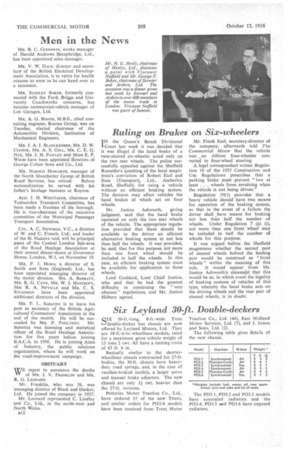Ruling on Brakes on Six-wheelers
Page 46

If you've noticed an error in this article please click here to report it so we can fix it.
I N the Queen's Bench Divisional Court last week it was decided that it was illegal if the hand brake of a twin-steered six-wlaeeler acted only on the two rear wheels. The police successfully appealed against the Sheffield Recorder's quashing of the local magistrate's conviction of Robert Earl and Sons (Transport), Ltd., Amberley Road, Sheffield, for using a vehicle without an efficient braking system. The decision may affect vehicles the hand brakes of which act on four wheels.
Mr. Justice Ashworth, giving judgment, said that the hand brake operated on only the two rear wheels of the vehicle. The appropriate regulation provided that there should be available to the driver an efficient alternative braking system to not less than half the wheels. It was provided, he said, that for this purpose not more than one front wheel should be included in half the wheels. In this case, an efficient braking system must be Available for application to three wheels.
Lord Goddard, Lord Chief Justice, who said that he had the greatest difficulty in construing the "very obscure" regulations, and Mr. justice Hilbery agreed. Mr. Frank Earl, secretary-director of the company, afterwards told The Commercial Motor that the vehicle was an Albion four-wheeler converted to four-wheel steering.
A legal correspondent writes: Regulation 10 of the 1955 Construction and Use Regulations prescribes that a parking brake must prevent "two at least . . wheels from revolving when the _vehicle is not being driven."
Regulation 39(1) provides that a heavy vehicle should have two means' for operation of the braking system, so that in the event of a failure the driver shall ,have • means for braking not less than half the number of wheels. Under Regulation 7 (a) (i), not more than one front wheel may be included in half the number of wheels for this purpose.
It was argued before the Sheffield magistrates whether the second pair of steered wheels behind the leading pair would be construed as " front wheels" within the meaning of this rule, It would appear from Mr. Justice Ashworth's statement that this would be so, in which event the legality. of braking systems of vehicles of this type, whereby the hand brake acts on the driving wheels and the rear pair of steered wheels, is in doubt.




















































































































